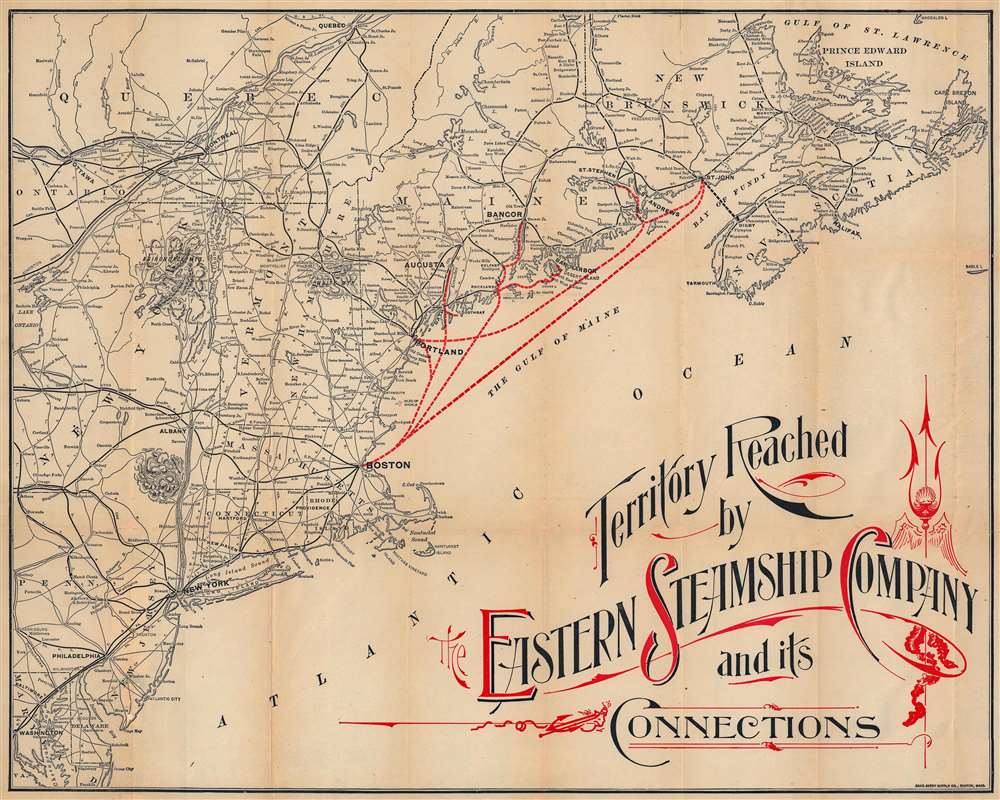This item has been sold, but you can get on the Waitlist to be notified if another example becomes available, or purchase a digital scan.
1905 Rand Avery Map of New England w/ Eastern Steamship Company Routes
EasternSteamshipCo-randavery-1905
Title
1905 (undated) 15.5 x 19.5 in (39.37 x 49.53 cm) 1 : 2700000
Description
A Transportation Map
Red overprinting illustrates the Eastern Steamship Company's routes along the eastern seaboard servicing Boston, Portland, Augusta, Bangor, and Bar Harbor in the United States, and St. Stephen, St. Andrews, and St. John in Canada. Bold black lines highlight major railroads. Among these are the New York, New Haven, and Hartford Railroad; the Boston and Maine Railroad; and the Delaware, Lackawanna, and Western Railroad. The region's minor railroad network appears as well, providing travelers a rather detailed overview of New England's travel options during the first decade of the 20th century.The Eastern Steamship Company - and an American Scoundrel
The Eastern Steamship Company (1901 – 1911) operated along the eastern seaboard of the United States and Canada. Wall Street financier and speculator Charles W. Morse (1856 - 1933) organized the Eastern Steamship Company in 1901 by consolidating the Boston and Bangor Steamship Company, the Portland Steam Packet Company, and the International Steamship Company. Morse expanded the steamship network by acquiring the two overnight Hudson river steamboat lines, People's Line and the Citizens' Line. Then, in 1906 and 1907, Morse bought several more steamship companies, including the Metropolitan Steamship Company, the New York and Cuba Mail Steamship Company, and the New York and Porto Rico Steamship Company. The Morse steamship empire, after impressive growth, failed during the Panic of 1907 and caused Morse's banking interests to collapse. Morse was indicted by the United States District Attorney and convicted of violating federal banking laws. He was given a fifteen-year jail sentence but remained free on appeal. The steamship company was reincorporated in Maine in 1909 with Morse as president and then became the Eastern Steamship Corporation in 1911. That corporation fell into receivership in 1914 but emerged as Eastern Steamship Lines in 1917.To return to Morse, he finally reported to the Atlanta penitentiary in January 1910 and was imprisoned alongside Charles Ponzi (who would later create the infamous Ponzi scheme). Morse fell ill in 1912 and was diagnosed with Bright's Disease, along with other maladies, and it was determined that he would die if he remained in prison. This earned him a pardon from President William Howard Taft. Once out of prison, Morse left for Wiesbaden, Germany, to seek treatment. Not long after he left the Justice Department learned that Morse had faked his illness by drinking a combination of soapsuds and chemicals. His association with Eastern (but not shipping) ends here.
Publication History and Census
This map was created by Rand Avery and published by the Eastern Steamship Company c. 1905. Admittedly, since this map is undated, it could date from any time during the existence of the Eastern Steamship Company, which was from 1901 until 1911. We note two cataloged examples which are part of the collection of the Osher Map Library at the University of Southern Maine and Harvard University, but there is a discrepancy in the cataloged publication dates.Cartographer
Rand, Avery, and Company (1851 – 1886) was a Boston based book and map printer active in the late 19th century. The company was founded in 1851 by George Curtis Rand (December 13, 1819 – December 30, 1878) and his brother-in-law Abraham Avery (November 15, 1824 - April 3, 1893). George C. Rand was a brother to William H. Rand of Rand, McNally, and Company of Chicago. George C. Rand was born in Woodstock, Vermont, to Baptist minister John Rand (1781 – 1855) and his wife. Rand began working in the printing industry from at least the 1840s, wherein he mostly produced religious tracts. He married Julia Avery in 1851 and brought his brother-in-law, Abraham Avery, into the business, renaming the firm Rand, Avery, and Company. Avery was born in Wibraham, Massachusetts and studied at Wesleyan University, which his father helped to found. Rand, Avery, and Company was based in Cornhill, Boston, and was, for a time, they were the largest printers in New England. Such works as Uncle Tom's Cabin were included in their catalog. Avery retired when Rand died in 1878, but the firm continued to publish under another generation of managers, including Rand's son, Avery L. Rand, until at least 1886. They also took on a fourth partner, Orrin F. Frye, and published as Rand, Avery, and Frye. After retiring Avery moved to Los Angeles where he died in 1893. It appears that this firm also published under the name the Rand Avery Supply Company. More by this mapmaker...

